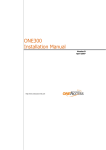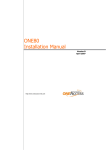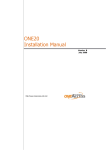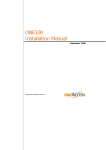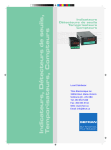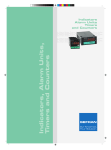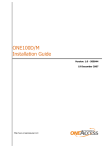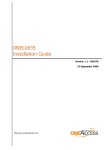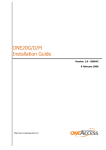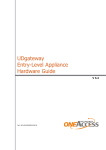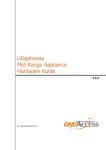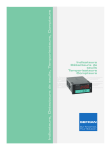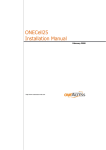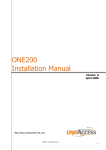Download ONE180 Installation Manual
Transcript
ONE180 Installation Manual Version C April 2007 http://www.oneaccess-net.com ONE180 – Installation Manual 1 OneAccess 28, rue de la Redoute 92260 Fontenay aux Roses France The law of 11 March 1957, paragraphs 2 and 3 of article 41, only authorizes, firstly, ’copies and reproductions strictly reserved for use by copyists and not for general use and, secondly, analyses and short quotations for the purpose of example and illustration. Therefore, ’any representation or reproduction, entire or partial, made without the consent of the author or his representatives is illegal’ (paragraph 1 of article 40). Any such representation or reproduction, made in any manner whatsoever, would therefore constitute an infringement of the law as sanctioned by articles 425 and in accordance with the penal code. Information contained in this document is subject to change without prior notice and does not constitute any form of obligation on the part of OneAccess. OneAccess and the distributors can in no case be held responsible for direct or indirect damage of any kind incurred as a result of any error in the software or guide. Every care has been taken to ensure the exactitude of information in this manual. If however you discover an error, please contact OneAccess After Sales Service division. Edition August 2006 1000 00 N 4022 844 C 00 ind. B 2 ONE180 – Installation Manual How to Read this Manual The present document is broken down into 8 chapters. Chapter 1 – Safety Instructions This chapter provides the safety instructions for use and installation of the router. Chapter 2 – Router Description This section describes the router front and rear panels and the associated technical characteristics. Chapter 3 – Interface Description This section describes the router interfaces. Chapter 4 - Installation This chapter describes how to modify the jumper positions and gives instructions to connect the router. Chapter 5 – Power-up This chapter describes the device power-up and how to monitor the self-test progress. Chapter 6 – Technical Characteristics This section describes technical characteristics such as operating conditions. Chapter 7 – Directives and Standards This chapter details the list of standards, which the device complies with. Appendix – Connection Description This chapter provides the pin-out of cables that are compatible with the router. ONE180 – Installation Manual 3 Table of Contents HOW TO READ THIS MANUAL ...........................................................................................................................3 TABLE OF CONTENTS...........................................................................................................................................4 1 1.1 1.2 1.3 SAFETY INSTRUCTIONS...........................................................................................................................5 Connection to Power Supply .....................................................................................................................5 Overcurrent Protection...............................................................................................................................5 Safety Level Interface ................................................................................................................................5 2.1 2.2 DIRECTIVES AND STANDARDS .............................................................................................................6 Declaration of Conformity .........................................................................................................................6 Standards ....................................................................................................................................................7 3.1 3.2 3.3 3.4 ROUTER DESCRIPTION.............................................................................................................................8 Hardware Description ................................................................................................................................8 Front Panel ...............................................................................................................................................10 Rear Panel ................................................................................................................................................11 Configuration Identification.....................................................................................................................16 4.1 4.2 4.3 4.4 4.5 4.6 INTERFACE DESCRIPTION.....................................................................................................................17 G.SHDSL Interface (SHDSL) .................................................................................................................17 Console interface (CONSOLE) ...............................................................................................................18 Switch Interface (SWITCH) ....................................................................................................................19 FXS Analog Interface (FXS) ...................................................................................................................20 FXO Analog Interface (FXO) ..................................................................................................................21 T0/S0 Digital Interface (ISDN BRI)........................................................................................................22 5.1 5.2 5.3 INSTALLATION.........................................................................................................................................26 Opening the Chassis.................................................................................................................................26 Extension Board .......................................................................................................................................27 Connection ...............................................................................................................................................28 2 3 4 5 6 POWER-UP .................................................................................................................................................29 7 7.1 7.2 7.3 TECHNICAL CHARACTERISTICS .........................................................................................................30 Climatic Environment ..............................................................................................................................30 Power Supply ...........................................................................................................................................30 Dimensions...............................................................................................................................................30 8.1 8.2 DIRECTIVES AND STANDARDS ...........................................................................................................31 Declaration of Conformity .......................................................................................................................31 Standards ..................................................................................................................................................32 8 ANNEXE A: CONSOLE CABLE..........................................................................................................................34 4 ONE180 – Installation Manual 1 Safety Instructions The following symbol instructs the user to read the manual carefully before any connection: 1.1 Connection to Power Supply To connect the power supply, always follow these steps: • • Connect the DC input jack from the power supply to the DC 12V power input on the rear panel of the router, Connect the power supply to an AC electrical outlet (100-240 VAC). Plugging in the power supply turns on the router. Unplug the AC input before assembling/disassembling any part on the device. The AC input is the part you must disconnect first. For safety reasons, you shall be able to easily access this part. 1.2 Overcurrent Protection The product requires that the building’s electrical installation is designed for protection against short-circuit (over current) protection. A fuse or circuit breaker no larger than 240 VAC, 10A must be used on the phase conductors. 1.3 Safety Level Interface All safety levels of the interfaces are described in each paragraph presenting the interfaces (paragraphs 3.1 to 3.6). The interface modules and optional boards can be installed only in the products authorized by OneAccess and only by qualified staff as recommended in the installation manual. The ONE180 with FXS interfaces has got a screw located on the rear panel. This must be permanently connected to the main protective earth. ONE180 – Installation Manual 5 2 Directives and Standards 2.1 Declaration of Conformity 6 ONE180 – Installation Manual 2.2 Standards The ONE180 is designed in conformity with the standards listed hereafter, provided that the basic housing, modules, interface boards and installation kits are mounted as recommended in the corresponding installation manual(s). Safety EN60950-1: 2001, First Edition Safety of information technology equipment, including electrical business equipment. Environment: Climatic, physico chemical, mechanic, packing ETS 300 019-1 (95) Environmental conditions and environmental testing for telecommunication equipment In use: Temperature Controlled Test specification: Part 1, Classification of environmental conditions - class T3.1 (normal) - class T3.1 (exceptional) Storage: partly temperature controlled T1.1 Part 2, Specification of environmental test Transportation: careful Transportation T2.3 Electromagnetic Compatibility, immunity ETSI EN 301 489-17 V1.2.1 ElectroMagnetic Compatibility (EMC) standard for radio equipment and services. (2002-08) Part 17: Specific conditions for 2,4 GHz wideband transmission systems and 5 GHz high performance RLAN equipment. ETSI EN 300 328 V1.6.1 ETSI EN 300 386 V.1.3.3 (2005-04) Data transmission equipment operating in the 2,4 GHz ISM band and using wide band modulation techniques; Harmonized EN covering essential requirements under article 3.2 of the R&TTE Directive. Telecommunication network equipment; ElectroMagnetic Compatibility (EMC) requirements. Waste Electrical and Electronic Equipment 202/96/EC The ONE180 respects the European directive on the waste disposal from the electrical and electronics components. Restricted use of Hazardous Substances (RoHS) 2002/95/EC The ONE180 respects the European directive on the restricted use of Hazardous Substances in electric and electronic equipment. ONE180 – Installation Manual 7 3 Router Description 3.1 Hardware Description This section details the various types of services offered by the ONE180. The described configurations are the maximum configurations for the motherboard and the extension modules. Other configurations can be derived by under-equipment. Indeed, the ONE180 can have fewer interfaces compared to those presented below. The acronyms mentioned in bold between brackets locate markings of the interfaces back panel. 3.1.1 Motherboard Interface The ONE180 motherboard is equipped with the following interfaces. The interface marking is indicated in bold and between brackets. • • • 1 G.SHDSL access network (2 or 4 wires) (SHDSL), 1 Console port (CONSOLE), 1 Managed switch 4 ports (SWITCH). Optional Interfaces factory mounted: • 3.1.2 WLAN 802.11b/g with 2 antennas (managed by the method « antenna diversity »). Extension Modules Additional services are available in option on the daughter-board described below. 3.1.2.1 2 BRI and 2 FXS board This board in its complete configuration has the following interfaces. The interface marking is indicated in bold and between brackets. • • 2 ISDN Basic Rate Interfaces S0/T0 configurable TE or NT mode (ISDN BRI), 2 Analog voice interfaces FXS (FXS). 3.1.2.2 4 BRI and 2 FXS board This board in its complete configuration has the following interfaces. The interface marking is indicated in bold and between brackets. • 8 4 ISDN Basic Rate Interfaces S0/T0 configurable TE or NT mode (ISDN BRI), ONE180 – Installation Manual • 2 Analog voice interfaces FXS (FXS). 3.1.2.3 8 FXS and 1 FXO board This board in its complete configuration has the following interfaces. The interface marking is indicated in bold and between brackets. • • 8 Analog voice interfaces FXS (FXS). 1 analog access designed to connect telephone line (FXO interface) (FXO), 3.1.2.4 4 BRI board This board in its complete configuration has the following interfaces. The interface marking is indicated in bold and between brackets. • 4 ISDN Basic Rate Interfaces S0/T0 configurable TE or NT mode (ISDN BRI). 3.1.2.5 4 + 4 BRI board This board in its complete configuration has the following interfaces. The interface marking is indicated in bold and between brackets. • • 4 ISDN Basic Rate Interfaces S0/T0 configurable TE or NT mode (ISDN BRI). 4 ISDN Basic Rate Interfaces S0/T0 in TE mode (ISDN BRI). ONE180 – Installation Manual 9 3.2 Front Panel The front panel is provided with LEDS, which inform about the status of several router functions. Figure 1. Front Panel Leds OFF Green Red Status Switched Off Switched On Switched On & & Operational Not operational Uplink No SHDSL lines configured All SHDSL lines are synchronized All SHDSL lines are not synchronized (loss of signal) IP Not used All IP interfaces are up All IP interfaces are down WLAN Not used Interface up Aux No auto Auto configurat configuration ion successfully completed 10 Blinking Red Orange Blinking Green Reboot in progress Minimum one configured SHDSL line is not synchronized (loss of signal) Minimum one SHDSL line is in the progress of synchroniz ation At least one IP Interface is not up (example: PPPoA not connected) Traffic in progress Auto configuratio n in progress ONE180 – Installation Manual 3.3 Rear Panel This section details the various types of ONE180 rear panel so that the user can identify the interface type and port numbering. It should be noted that only the fully-loaded configurations are represented. Other configurations can be derived by not providing some interfaces represented on the product. The configurations below are presented as an example. OneAccess reserves the right to market them or not. 3.3.1 Configuration with 2 BRI, 2 FXS The interface marking is indicated in bold and between brackets. All the connectors are located on the rear panel: • • • • • • • 1 SHDSL access port (RJ45) (SHDSL), 1 Configuration port and debug (RJ45) (CONSOLE), 4 FastEthernet switch ports (RJ45) (SWITCH E3-0/3 to E0-0/0), 2 Analog voice interfaces to connect telephones (FXS interface) (RJ45), (FXS L2-5/2 to L3-5/3) 2 ISDN Basic Rate Interface (RJ45) (ISDN BRI L0-5/0 to L1-5/1), Input for the external power supply connector (DC input jack, 12V-2.2A), 2 connectors for WLAN antenna. Figure 2. Rear panel with 2 BRI and 2 FXS Depending of the ordered configuration of the system, the rear panel may change. ONE180 – Installation Manual 11 3.3.2 Configuration with 4 BRI, 2 FXS The interface marking is indicated in bold and between brackets. All the connectors are located on the rear panel: • • • • • • • 1 SHDSL access port (RJ45) (SHDSL), 1 Configuration port and debug (RJ45) (CONSOLE), 4 FastEthernet switch ports (RJ45) (SWITCH E3-0/3 to E0-0/0), 2 Analog voice interfaces to connect telephones (FXS interface) (RJ45), (FXS L4-5/4 to L5-5/5) 4 ISDN Basic Rate Interface (RJ45) (ISDN BRI L0-5/0 to L3-5/3), Input for the external power supply connector (DC input jack, 12V-2.2A), 2 connectors for WLAN antenna. Figure 3. Rear panel with 4 BRI and 2 FXS Depending of the ordered configuration of the system, the rear panel may change. 12 ONE180 – Installation Manual 3.3.3 Configuration with 8 FXS, 1 FXO The interface marking is indicated in bold and between brackets. All the connectors are located on the rear panel: • • • • • • • 1 SHDSL access port (RJ45) (SHDSL), 1 Configuration port and debug (RJ45) (CONSOLE), 4 FastEthernet switch ports (RJ45) (SWITCH E3-0/3 to E0-0/0), 8 Analog voice interfaces to connect telephones (FXS interface) (RJ45), (FXS L0-5/0 to L7-5/7) 1 analog telephone access to connect telephone line (FXO interface) (RJ45), (FXO L8-5/8), Input for the external power supply connector (DC input jack, 12V-2.2A), 2 connectors for WLAN antenna. Figure 4. Rear panel with 8 FXS and 1 FXO Depending of the ordered configuration of the system, the rear panel may change. ONE180 – Installation Manual 13 3.3.4 Configuration with 4 BRI The interface marking is indicated in bold and between brackets. All the connectors are located on the rear panel: • • • • • • 1 SHDSL access port (RJ45) (SHDSL), 1 Configuration port and debug (RJ45) (CONSOLE), 4 FastEthernet switch ports (RJ45) (SWITCH E3-0/3 to E0-0/0), 4 ISDN Basic Rate Interface (RJ45) (ISDN BRI L0-5/0 to L3-5/3), Input for the external power supply connector (DC input jack, 12V-2.2A), 2 connectors for WLAN antenna. Figure 5. Rear panel with 4 BRI Depending of the ordered configuration of the system, the rear panel may change. 14 ONE180 – Installation Manual 3.3.5 Configuration with 4 + 4 BRI The interface marking is indicated in bold and between brackets. All the connectors are located on the rear panel: • • • • • • • 1 SHDSL access port (RJ45) (SHDSL), 1 Configuration port and debug (RJ45) (CONSOLE), 4 FastEthernet switch ports (RJ45) (SWITCH E3-0/3 to E0-0/0), 4 ISDN Basic Rate Interface NT/TE (RJ45) (ISDN BRI L0-5/0 to L3-5/3), 4 ISDN Basic Rate Interface TE (RJ45) (ISDN BRI L4-5/4 to L7-5/7), Input for the external power supply connector (DC input jack, 12V-2.2A), 2 connectors for WLAN antenna. Figure 6. Rear panel with 4 + 4 BRI Depending of the ordered configuration of the system, the rear panel may change. ONE180 – Installation Manual 15 3.4 Configuration Identification The different device configurations are identified by adding one or several letters to the device naming and printed on the router labelling sticker. Option codification: • • • • • B: Digital voice interfaces (BRI) V: Analog voice interfaces (FXS) D: G.SHDSL access 1 to 2 pairs (2 to 4 wires), 8: 8 voice communication channels available W: Wireless LAN Example: ONE180-4B-2V D8 is an ONE180 router equipped with: • • • • 16 1 access G.SHDSL 2/4 wires, 4 BRI interfaces 2 FXS interfaces 8 voice communications ONE180 – Installation Manual 4 Interface Description 4.1 G.SHDSL Interface (SHDSL) 4.1.1 Safety Level of G.SHDSL (SHDSL) interface The G.SHDSL interface is TNV-1 (Telephone Network Voltage type 1). It must be connected to a standard telephone line (external). 4.1.2 Characteristics • • 4.1.3 ITU-T G.991.2 for the G.SHDSL (Annex A and B), 2 or 4 wires, Capacity: • SHDSL 1 pair (2 wires): 192 kbps up to 2 320 kbps, • SHDSL 2 pairs (4 wires): 384 kbps up to 4 640 kbps. Connector Pinout RJ45 connector: 4.1.4 Pin Signal Pin Signal 1 Line 2 5 Line 1 2 Line 2 6 NC 3 NC 7 NC 4 Line 1 8 NC Cables For the connection of the G.SHDSHL interface, use the shielded cable that comes with the equipment. ONE180 – Installation Manual 17 4.2 4.2.1 Console interface (CONSOLE) Characteristics • • • 4.2.2 RS232, 9600 bps, 8 bits, 1 bit for stop, no parity. Connector Pinout RJ45 connector: Pin • • • • 4.2.3 Signal Signal TX 5 NC 2 RX 6 NC 3 GND 7 NC 4 NC 8 NC TX: Emission RX: Reception NC: Not Connected GND: Ground Cable The console cable is defined in Appendix A. 18 Pin 1 ONE180 – Installation Manual 4.3 4.3.1 Switch Interface (SWITCH) Safety level of Switch interface The Ethernet 10/100 Mbps auto-sense has a ’SELV’ (Safety Extra Low Voltage) interface. They must be used only for indoor applications, connected to a 10/100 Mbps interface, which has also the ’SELV’ characteristics. 4.3.2 Characteristics The Ethernet Switch function offers 4 additional Ethernet ports. Each of this port can be switched and/or routed. • • • • 4.3.3 10/100 Mbits/s, Half or full duplex, Auto-negotiation, Auto MDI/MDIX. Meaning of LED colors Green LED Lit Blinking yellow LED 4.3.4 Link active Traffic in progress Connector Pinout RJ45 connector: 4.3.5 Pin Signal Pin 1 TD (+) 5 Signal NC 2 TD (-) 6 RD (-) 3 RD (+) 7 NC 4 NC 8 NC Cables The cables are shielded, crossover/straight cables with 4 twisted pairs. The switch supports auto detection of crossover/straight cable (’auto-MDI/MDI-X detection’); the transmission pairs are (1-2) and receive (3-6). ONE180 – Installation Manual 19 4.4 FXS Analog Interface (FXS) The FXS interface enables the connection of up to 8 analog telephone lines thus providing up to 8 analog voice interfaces. The connection of the FXS interfaces is done via RJ45 connectors (1 connector per FXS). 4.4.1 Safety Level of FXS Interface The FXS modules offer up to 8 FXS accesses (RJ45 connectors). These Interfaces are TNV-2. 4.4.2 Characteristics • • • • • • • • 4.4.3 Line impedance: 600 Ω or complex, Frequency range of the ringing signal: 16Hz to 70 Hz, Voltage of the ringing signal: > 37,4VRMS for a load of 1 REN (6,93K + 8µF @ 20Hz) in the frequency range, Line current: 27 mA max. for a line resistance <1000 Ω, Polarity inversion of the TIP and RING pins, Line current <2mA in the power-down mode, Q.23 dialing, Ringer Equivalency Number (REN) : 1 Connector Pinout The connection to the analog voice interface is made on the rear panel via an RJ45 connector. The connector pinout is as follows: Pin 4.4.4 Signal Pin Signal 1 NC 5 TIP 2 NC 6 NC 3 NC 7 NC 4 RING 8 NC Cables The cable used for a connection toward an analog phone is an unshielded cable including 1 twisted pair. The ONE180 with FXS interfaces has got a screw marked located on the rear panel. This must be permanently connected to the main protective earth. 20 ONE180 – Installation Manual 4.5 FXO Analog Interface (FXO) The FXO module enables the connection of 1 analog telephone line. The connection of the FXO interfaces is done via RJ45 connectors (1 connector per FXO). These Interfaces are TNV-3. 4.5.1 Connector Pinout RJ45 Connector: Pin 4.5.2 Signal Pin Signal 1 NC 5 TIP 2 NC 6 NC 3 NC 7 NC 4 RING 8 NC Cables The cable used for a connection toward a standard analog phone is an unshielded cable including 1 twisted pair. ONE180 – Installation Manual 21 4.6 T0/S0 Digital Interface (ISDN BRI) The ONE180 supports up to 4 ISDN T0/S0 interfaces. The interfaces can be configured in TE or NT. The ONE180 can receive a module that has 2 or 4 digital interfaces. The connection of the digital voice interface is carried out on the rear panel via RJ45 connectors (1 connector per interface). 4.6.1 Safety Level of T0/S0 Interface The T0/S0 modules marked ISDN BRI offer up to 4 ISDN (BRI) interfaces (RJ45 connector). These interfaces are TNV-1. The factory configuration of these interfaces is T0, NT mode. Do not connect the interfaces to a public ISDN access without adapting jumper position, which can damage the product immediately. 4.6.2 Connector Pinout The connection to the access voice interface is made on the rear panel via an RJ45 connector. The connector pinout is as follows: Pin 4.6.3 Signal Pin Signal 5 TX (-) 1 NC 2 NC 6 RX (-) 3 RX (+) 7 NC 4 TX (+) 8 NC Jumper Setting Every ISDN interface has four jumpers making it possible to configure the following options: • • 22 100 Ohms impedance adaptation, Power-feeding for ISDN phones ONE180 – Installation Manual The drawing below presents the position of the 4 blocks of 4 jumpers on the daughter card of the configuration ONE180-4B D8 and the WATCHDOG, RESET and JTAG position on the motherboard: Motherboard J12 X4 X5 Daughter Card J2 J4 RNIS 0 J6 RNIS 1 J8 RNIS 2 RNIS 3 The drawing below presents the position of the 4 blocks of 4 jumpers on the daughter card of the configuration ONE180-2B-2V D8 (RNIS 0-1) and ONE180-4B2V D8 (RNIS 0-3) and the WATCHDOG, RESET and JTAG position on the motherboard: Motherboard J12 X4 X5 Daughter Card J2 RNIS 0 ONE180 – Installation Manual J4 RNIS 1 J6 J8 RNIS 2 RNIS 3 23 The WATCHDOG jumper must always be connected so that OneAccess guarantees the correct operation of the ONE180. Description of a block of jumpers for a BRI interface: 100 Ohms Adaptation Receiving Pair 100 Ohms Adaptation Sending Pair Power supply 30 VP Power supply 30VN Not used Each block of jumpers allows: • • To connect or not a 100 Ohms impedance adaptation, To connect the power supply for ISDN terminal (30 volts). For the power feeding, jumpers operating in pairs: • • No power feeding, both jumpers removed, With power feeding, both jumpers set. For 100 Ohms adaptation, jumpers can be used in sending, in receiving or in sending/receiving. You find below some examples of configurations according to the position of the jumpers: Configuration without impedance adaptation and power feeding of the terminal: Configuration 100 Ohms impedance adaptation disconnected. Power feeding for ISDN terminal disconnected. 24 ONE180 – Installation Manual Configuration with impedance adaptation and without power feeding of the terminal: Configuration 100 Ohms impedance adaptation connected. The first jumper of the pair is associated with the transmission, the second one with the reception. Power feeding for ISDN terminal disconnected. Configuration without impedance adaptation and with power feeding of the terminal: Configuration 100 Ohms impedance adaptation disconnected. Power feeding for ISDN terminal connected. Configuration with impedance adaptation and with power supply of the terminal: Configuration 100 Ohms impedance adaptation connected. The first jumper of the pair is associated with the transmission, the second one with the reception. Power feeding for ISDN terminal connected. ONE180 – Installation Manual 25 5 Installation Always unplug the power AC cable before any hardware maintenance operation. This chapter describes assembling/disassembling operations for optional modules. The user should be aware that the router software auto-detects on-board modules and interfaces. All vacant slots of the rear panel must be obstructed with suitable faceplates in order to guarantee the respect of the EMC standards as defined in Chapter 7. Directives and Standard 5.1 Opening the Chassis 1 2 26 Unlock the 2 screws located on each side of the cover, Remove the cover. ONE180 – Installation Manual 5.2 Extension Board The installation or exchange of a daughter board requires remove the cover (see chapter 4.1). Figure 7. Removal-Installation of an Extension Board 5.2.1 Removal of an extension board • • • • 5.2.2 Unscrew and remove the cover, Unscrew the fixing stand of the module on the motherboard, Loosen the module from the motherboard connection connector, Loosen the module from the motherboard connector by gently separating the motherboard and the module. Installation of an extension board • • • • • • Unscrew and remove the cover, Remove the protective faceplate of the slot, Position the module so that the module metallic faceplate fits in the place made available by the removal of the faceplate, Lower the module while aligning the module with the motherboard connector, Plug the module into the motherboard connector, Screw the fixing stand. ONE180 – Installation Manual 27 5.3 Connection The external power supply is connected on the rear panel of the device. The external power supply is delivered with the router package. • • Connect the ’jack’ connector of the external power supply to the connector marked ’12V-2.2A’ device connector, Secure the power supply connection by installing the DC power supply cord into the plastic ring. The device shall not be used with another power supply than a power supply provided by OneAccess. 28 ONE180 – Installation Manual 6 Power-up To power up the device, always follow these steps: • • Connect the DC power input jack from the power supply to the DC power input of the rear panel of the router, Connect the power supply to the AC mains (100-240 V AC). The connection of the power supply causes the switch-on of the equipment. Few seconds after power-on, the device performs a series of self-tests and loads the software into memory (RAM), during which the ’STATUS’ LED on the front panel blinks: • The ’STATUS’ LED light remains steady green if software initialization was successful, • The ’STATUS’ LED blinks in case of software absence or error during software loading. Refer to the Software and ONEOS User Guide for more information. ONE180 – Installation Manual 29 7 Technical Characteristics 7.1 Climatic Environment Operating Conditions: Temperature 0° C ≤ T ≤ 45°C Relative Humidity (HR) 5% ≤ HR ≤ 80% Absolute Humidity ≤ 24g / m3 Altitude ≤ 2500 m Storage Environment: 7.2 - 25° C to 55° C Relative Humidity (HR) 5% ≤ HR ≤ 80% Absolute Humidity ≤ 24g / m3 Altitude ≤ 2500 m Power Supply • 7.3 Temperature External Power Supply 100-240 VAC / 26,5W (12V – 2,2A), Dimensions The dimensions of the housing are: 30 Width 320 mm Height 1U Depth 200 mm ONE180 – Installation Manual 8 Directives and Standards 8.1 Declaration of Conformity In progress ONE180 – Installation Manual 31 8.2 Standards The ONE180 is designed in conformity with the standards listed hereafter, provided that the basic housing, modules, interface boards and installation kits are mounted as recommended in the corresponding installation manual(s). Security EN60950-1:2001 First Edition Safety of information technology equipment, including electrical business equipment. Energy ETSI EN 300 132 Power supply interface at the input to telecommunications equipment • Part 1 Operated by alternating current (ac) derived from direct current (dc) sources ETSI EN 300 132-3 : Power supply interface at the input to telecommunications equipment • Part 3 Operated by rectified current source, alternating current source or direct current source up to 400 V Security Environment : Climatic, physico chemical, mechanic, packing ETS 300 019-1 (95) Environmental conditions and telecommunication equipment environmental In use : Temperature Controlled Test specification: Part 1, Classification of environmental conditions - class T3.1 (normal) - class T3.1 (exceptionnal) Storage: partly temperature controlled T1.1 Part 2, Specification of environmental test Transportation: careful transportation T2.3 32 ONE180 – Installation Manual testing for Telecom ITU-T K21 on G.SHDSL (2003-07) Resistibility of telecommunication equipment installed in customer premises to over-voltages and over-currents Electromagnetic Compatibility, immunity EN 300386 V.1.3.3 (2005-04) Telecommunication network equipment; ElectroMagnetic Compatibility (EMC) requirements EN 301489-17 V1.2.1 (2002-08) ElectroMagnetic Compatibility (EMC) standard for radio equipment and services;Part 17: Specific conditions for 2,4 GHz wideband transmission systems and 5 GHz high performance RLAN equipment EN 300328 V1.6.1 (2004-11) Wideband transmission systems; Data transmission equipment operating in the 2,4 GHz ISM band and using wide band modulation techniques;Harmonized EN covering essential requirements under article 3.2 of the R&TTE Directive Waste Electrical and Electronic Equipment 2002/96/EC The ONE180 respects the European directive on the waste disposal from the electric and electronic equipment. Restricted use of Hazardous Substances (RoHS) 2002/95/EC The ONE180 respects the European directive on the restricted use of Hazardous Substances in electric and electronic equipment. ONE180 – Installation Manual 33 Annexe A: Console Cable Catalog reference: 4 022 332 B 00 Ed A P1 34 To PC serial port in terminal mode (Configuration) P2 RJ45 - P1 SIGNAL SUB-D 9 Pts Female - P2 1 2 3 TX RX GND 2 3 5 ONE180 – Installation Manual


































